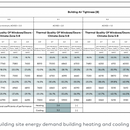Is it really worth it?
Is it really worth it?
We have been planning our new house for several years and I have had a pretty extreme emphasis on air sealing, windows/doors and insulation to make the house more energy efficient.
I’m guessing the extra stuff I want to do between air sealing details, better windows/doors and more insulation will probably set me back about $45K on a house that has a living space footprint of 2,250 square feet with a full basement underneath it. Actually, I’m not including the ERV in there so maybe more like $60K.
From my energy analysis from EMU this effort will probably save me around 40% on my energy bill (shooting for 1 ACH50 or less plus medium insulation package and B grade windows in the chart below).
Seems like a lot until you figure a code minimum house will likely only be about $120/month to heat and cool on average so saving 40% is only saving $500/year.
The ROI there isn’t even 1%. In other words, horrible.
I still want to do all of this stuff but I’m beginning to think I’m crazy in the head for wanting to do anything more than code minimum.
GBA Detail Library
A collection of one thousand construction details organized by climate and house part










Replies
Just noticed there is a similar post just a few posts down from mine. Sorry for a somewhat redundant post:
https://www.greenbuildingadvisor.com/question/is-building-science-really-energy-efficient
To actually predict your ROI over a long period of time you
have to be able to predict the effects of world wide economic
trends on the price of your energy source for heat over the same
period - an impossible task! However, you have obviously made a
good educated guess. Nevertheless, when it comes to energy efficiency
the smart money is on "Higher is Better"!
Others have covered all these points in more detail, but in summary:
-The economic return on investment isn't always there, but can be optimized if you want to do that.
-There are significant durability advantages, especially with regard to moisture management, to some types of 'high performance' building enclosure designs. Air tightness often plays a major role in these designs. Note: it is possible to build an extremely energy efficient house that is not very durable.
-Comfort is a major factor and cannot necessarily be assessed with the lens of ROI. I did not personally buy a toilet with a heated bidet seat because I felt I would come out ahead on toilet paper costs, but it was worth it in terms of comfort.
I'm in virtually the same place as you, but costs here are _really_ high so I'm thinking more like $75-100k. A big part of that is going all electric with a heat pump sufficient for cold and high altitude. I'm justifying this in terms of comfort, long-term durability, and planning ahead with a house engineered and sited to accommodate a large solar array. I doubt my choices are 'optimal' economic decisions, but it feels like the right thing to do. I don't purchase clothes, books, food, or much of anything else (other than investments ...) based on ROI - it's more about 'value', which includes comfort, happiness, domestic tranquility (is my wife happy ...), contributing positively to community, and other intangibles. If you can afford it, I don't think you - or I - will regret the investment.
johngfc,
"I don't purchase clothes, books, food, or much of anything else (other than investments ...) based on ROI"
ROI is a very imperfect lens in which to look at this, but I think it comes up in these discussions because we are looking for some metric to decide how far to go. What ACH do you aim for? How much insulation is enough? Without any reference ROI, what informs those choices? Is it simply preference?
I'm going on a hunch here, with no hard data. But I think the 80/20 principle is at work. Put extra effort into air sealing. This is perhaps the least costly of all the interventions and one of the most effective. There are many different ways to do it depending on the details of your house. But a surprising improvement can be obtained by just taping all exterior sheathing joints and making sure openings are well sealed. A couple hundred dollars in tape and a few days of labor will cover it. I would focus on that before insulating above code or investing in expensive equipment. Of course those other things help too. But it's a question of bang for buck.